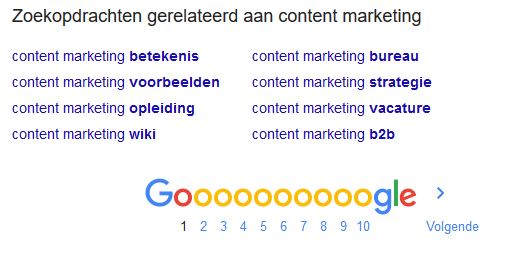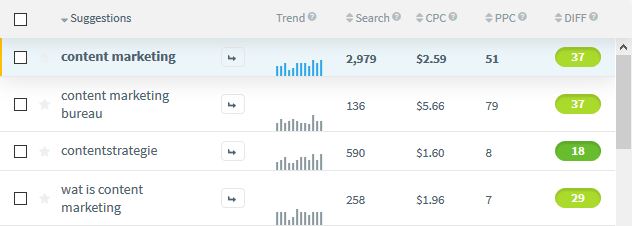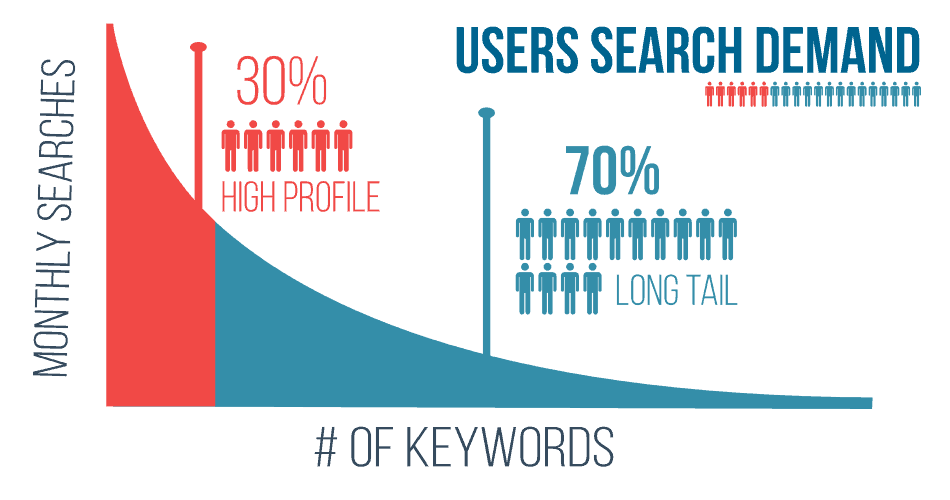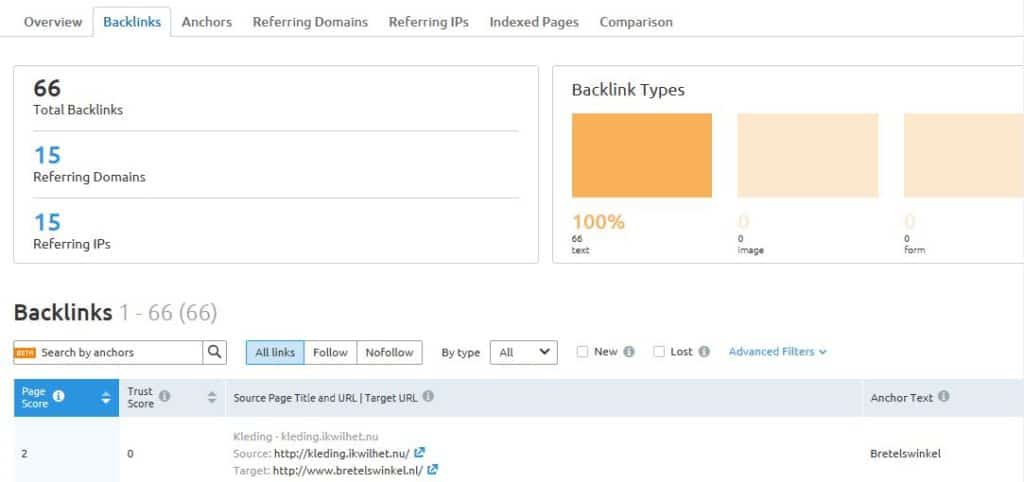Get a big SEO edge by writing smart.
That means you don’t just write about any topic you can find on your niche, you need to be smarter about it, especially when starting out and without a lot of authority.
That’s where keyword research comes in to help kickstart your niche site.
What is content marketing for niche sites?
In content marketing it is important to write articles for your customers. Articles that help your customers. How does my text improve my customer’s life? What can he do now that he couldn’t before?
Did I save him time by listing all the useful information about a topic? You must be able to answer at least one or more of these questions positively if your article is to be successful.
That is content marketing in a nutshell. You offer your visitors free help by means of top texts on your site and in exchange for this free information a number of visitors will automatically become customers.
The is the same when working on niche sites. You might just not sell a product or service, you probably just offer those as affiliate links.

You can easily expand the relationship with your customer on your content. They have gotten a positive feeling about your company and site because they have been helped, and the more often you can do that with related topics, the greater the chance that they will become a paying customer. They’re going to give it to you at some point because you helped them so bold.
But even the best help in the world is useless if no one ever reads it. A good content strategy and thorough research are also necessary.
That is why the start of writing your article is so important. The better the research you do in advance, the more people will find it through the organic results in Google. And that means free traffic to your article and to your site.
And as you may know, it’s a lot easier to convert the people who found your site into paying customers than people you spammed with ads.
We have a lot of tips here for you to get started with it properly and SEO responsible. Hopefully by the end of this piece you will also be a guru in this area. Then you will contribute from now on with your next articles. This way we as Marketers can make the world of search results a little better and more relevant for the searcher.
The start of your content marketing is keyword research
An investment in research in advance gives you an SEO advantage. Optimizing for search engines (Search Engine Optimization) based on good research shows you:
1. How many people search for a term
2. How much competition there is for that term
3. Which matters around the main topic are even more important
How many people search for a keyword per month?
Every article you write and with which you want to be found in Google starts with thorough keyword research. You probably already know about what you want to write about. The first step is then to see what search terms people search for in Google when they look up information on these types of topics.
First look at the main topic. How many searches per month do you find about this? This way you can steer a bit in the outline of the entire article.
How big is the competition for a keyword?
The second thing you want to know about the searches is the competition that is already on it. If the keyword is too difficult, you might want to look for an alternative with slightly less competition.
There may be fewer searches per month on this, but position 1 in Google for 200 searches per month is still better than page 3 in Google for 2000 searches per month. Hardly anyone goes past the first page of search results.
For example, I myself changed the main topic of this article after reviewing the search results. I wanted a piece on On Page SEO Optimization. The main topic is setting up a page with SEO in mind. I wanted to put the focus of the article on the importance of good keyword research.
That’s the outline of the article. After some research, I found out that it would be easier to write about content marketing and keyword research and I tailored the article accordingly.
Your research for possible keywords starts with a handy tool. When you type your search term into Google, for example content marketing, you will immediately see related searches. That looks something like this:

At the very bottom of the results on the page you will see a whole list of alternatives for your current search.

You can use any of these alternatives to write your piece. Apparently other people also look for these suggestions a lot when they search for content marketing and writing about them can help your visitors find more answers to their questions.
Not all commands will be relevant, but it’s a good idea. When you click on such a link, you will see the search results for that part, with new suggestions for even more keywords at the bottom, for example these when we click on content marketing strategy:

A handy keyword tool
You see, a good and free way to find related terms. You can also use the Google Keyword Planner that also adds the search volume. The downside of this is that everyone will get the same suggestions and so the competition will be a bit higher, and the estimated volume isn’t very accurate.
The tool I use is Keyword Finder. The big advantage of it is that you get a lot of suggestions that you won’t find in the Keyword Planner, plus you immediately get an estimate of the competition in the form of a difficulty:

We purchased the paid version, but you can also do a few searches a day to try it for free.
What is the competition doing?
The next step in your research is looking at the competition. Numbers are fun and can give you a lot of initial information about the feasibility of your SEO campaign. But in the end it’s also about the sites behind the numbers.
What kind of pieces are now at the top of Google for your search. Google your search term and see the top few results. What do you think of the information they provide? Do they help the customer well? Do you see room for improvement of this content?
Can you offer even more help and information that can help customers even further with their issue?
Content strategy: The Skyscraper technique
The latter is especially important since you want to offer the customer something extra. The question of whether you can come to the top in Google is also largely answered whether you deserve to be at the top, and that means a good content strategy.
This is one of the ways we do content marketing for our customers when they outsource their blog content to us.
When looking at those top few search results, it is important for yourself to answer whether you can offer more than the current content. Or actually, not so much more in text, but more in value.
What you can pay attention to is the amount of help the current pieces offer, or the way of communicating. If you can just convey it better or with more images and infographics (here’s how to use them for your niche site), for example, then you deserve to be above it.
You tower above the rest with your unique content and way of transmission and you deserve to be the highest Skyscraper in this field!
Related topics and your Skyscraper content
Your overall outline is important for the direction of the piece. You now know what it is best to write about and you have seen what the current competition is doing. Now you are going to build a tower that is much better than the best piece there is now. This way you leave the rest far in the distance behind you.
The rest of your article is built on:
1. The best pieces from your competitors’ articles
2. Research your own keywords for related search terms
Grab the best pieces from your competitors’ articles. Perhaps merge information from multiple competing articles into your own unique “epic content”. The most important thing is that you express it in your own words. So do not copy and paste blindly because that is killing for your SEO (you are then creating duplicate content, and Google does not like that at all. And not liking it in the world of Google means a big fat penalty with lower positions in the search results).
In addition, it is simply not allowed to literally steal other people’s text. You are doing research for your article, so you read a lot about your topic and then build your own insights and tips from that.
So… take the best ideas from the pieces and write it all for your target audience. The best tip I can give you in this area is to familiarize yourself with the matter. Read through the pieces from the other websites a few times until you can explain it to someone who doesn’t know anything about it…and then start writing from scratch. That way it really becomes your own words and your own content.
Offer that little bit extra with long-tail keywords
Then the second part of your keyword research comes in handy. That’s all the related terms you found. See which things potential visitors are looking for about this topic. Searches where someone types multiple words into Google at once are called long-tail keywords.
These are searches in which the person searches very specifically for an answer to a question. Very targeted because the more words someone uses, the more specific their search is.
The advantage of including as many of such terms as possible is the extra traffic you can gain from this. Your main keyword may have the most search traffic according to the statistics, but all the long-tail keywords together (keywords that won’t be as competitive as you think) exceed the search volume of the main keyword.

70% of the total search volume will be long tail keywords. Grab some of these long-tail keywords with low competition and good volume and use them as subheadings for your piece. If you can also answer these extra questions where your competition can’t, then you’re in the right place with your Skyscraper content.
Your article will then have more depth and offer more help for issues that really bother people.
You will see that you will automatically be found for many more terms than just your main term, and that is ultimately your goal. Get as much targeted and free traffic to your page as possible.
Writing SEO content
Now that you’ve done the research, you should have a pretty good idea of what your piece should look like. For example, I made my first outline of this article when I started writing it. You see the different topics that are covered in the piece (you also know immediately what to expect below):
- Content marketing based on keyword research (480 searches per month, 20 difficulty)
- What is content marketing? (258 searches, 25 difficulty)
- How many people search for a keyword per month? (258 searches, 25 difficulty)
- Competition on a keyword? (0 registered searches, 20 difficulty)
- Content Strategy: The Skyscraper Technique (Epic Content) (590 searches, 18 difficulty)
- Related long-tail keywords (50 searches, 19 difficulty)
- Writing seo texts (479 searches, 29 difficulty)
- Search engine optimization tips (36 searches, 30 difficulty)
- Content marketing and social media (0 registered searches, 30 difficulty)
- Top of Google (170 searches, 25 difficulty)
With this I will cover the most important terms on the topic “content marketing based on keyword research”. Hopefully I will help you as a visitor with an extensive article in which everything is discussed, and at the same time I have all kinds of long tail keywords on which I could be found. Win-win, nice!
With this outline you can write your SEO texts. First write it off on the basis of the preliminary research you have done and try not to think too much about optimization. That will come after that. The most important thing is that you first have a piece that is easy to read and in which you tell everything you have to offer.
Search engine optimization tips
Here I have some tips to do the ultimate SEO optimization for your content. You may have heard about keyword density. If you’ve read something about SEO before, you often see this coming back. I would advise you not to worry too much about this.
If you don’t know what it is yet, keyword density means how often (density) your keyword appears in the text. It is expressed as a percentage, for example 2.8%.
In the past, it was best for SEO to have your most important term reflected very often in the texts and in the headings and subheadings. At a certain point, Google intervened because you received illegible texts with keyword stuffing (stuffing your search term very often).
Then SEOs had to come up with an alternative and they started talking about a maximum keyword density between 2% and 3.5%. That meant that your exact search term (for example, content marketing) could only cover 2% of all words, so that’s 2 out of 100 words. This to ensure that Google saw that your article was important for that word, without you being punished for it.
That has long since ceased to be the case. With Semantic Search, Google can already see exactly what your text is about and you can even rank (appear in the search results) for words that do not even appear once on your page. As long as your piece helps on this subject.
It is better to use related terms in your texts as an alternative to your main word. This way Google knows that you cover many aspects of this same topic and so your piece is in-depth on this topic. The more relevant information you can share, the more you can help the visitor.
Semantic Search here means that the search engine understands which words are often used in combination with others, so which things should occur when you write a good article on a certain topic. The more of these related terms you use, the better it is for your relevance to the main topic.
When I say I wouldn’t worry too much about it, I mean you can just naturally write about a topic. When you write for the visitor, you probably won’t accidentally stuff your keyword.
At the same time, a good outline of your article in which all relevant terms appear as subheadings ensures that you include everything. This way you can put the most important things in a prominent place.
You have now collected all relevant topics. You’ve looked at your competitors’ content. You searched for related search terms. Now you can write a great piece with the best help a visitor could ask for.
It’s about quality, not quantity, don’t forget that. That said, the pages that rank highest in Google average between 2000 and 3000 words. Ahrefs did a great job of researching Google’s ranking factors and the highest correlation came from the size of the content.
But it is important not to forget that this is about added value, not added “fluff”.
Content marketing and social media
Now you have your most awesome piece of content on the face of the earth ready! You offer value, you offer depth. You offer the customer a solution to the problem he was facing. You have good texts, you have nice clear images to support your story and to give a little more color to the whole.
Now it’s important to get the first people to find it. Sharing on your social media accounts is a good first step for some initial visitors. Make sure you make it easy to share your content.
Put some share buttons in prominent places, for example a floating sidebar. Also don’t forget to check if it’s easy to share from a mobile! Most people who find your content on social media will read it on their mobile when they are on the go.
The more shares you can get from people who already follow you, the greater your reach will be because their friends and acquaintances will see it again. And a recommendation from someone you know is worth almost twice as much as just finding the content.
Hubspot indicates that a visitor is 71% more likely to make a purchase through a social recommendation.
In addition, showing the number of shares on your page itself is a good example of social proof that others see. If more people have shared your article, other visitors will also give more weight to your article and to your site or brand.
That’s social proof, proof that other people think your site is cool. Then your site will also be cool and your text and your other (paid) services will probably offer value.
Top of Google
No matter how good your article is, you won’t get to the top of Google yet. Your ranking in the search results depends on one more factor, and that is a pretty important one. Content is king they always say, but the links to your page are even more important for ranking. Only without the epic content you will never reach it at all.
It helps if you place your content on a website that already has quite a bit of value in itself. You can express the value of your site in your Domain Authority. That simply means how many valuable links are going to your overall website. So also to other pages on your site. If you don’t have that much Domain Authority yet, you can gradually build it up.
The second point is the Page Authority of your new page. This is determined by the number of links to that specific article. With those links you also automatically increase your Domain Authority.
If you don’t have that many links to your website yet, it will be a bit more difficult to end up higher in Google. We can help you with your general link profile if you’d like.
What will help you at this point is using the Skyscraper technique. It has the advantage that you have the best information about a subject. And having the best information can get people to link to you as a resource (and quite rightly so after all your hard work helping people).
To help you get cool links, you can look for the websites that are now linking to the competitor’s articles.
An informative email to these sites about your article and the value it can offer their visitors is a good way to get some links. Of course, not everyone will link to you. But if you can get a few that also have a good Domain Authority themselves, you get a big boost that will help you rank high in Google much faster.
You can find these links by analyzing the competitor’s pages with a tool like Semrush (check out my review).
Find some potential sites with the highest Page score and send them an email to inform them about your new blog article that their readers might also find interesting.
Joost Nusselder is The Content Decoder, a content marketer, dad and loves trying out new tools en tactics. He's been working on a portfolio of niche sites since 2010. Now since 2016 he creates in-depth blog articles together with his team to help loyal readers earn from their own succesful sites.

